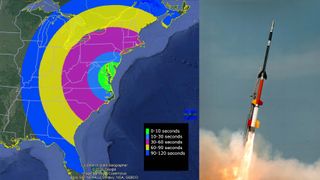NASA rocket launch may spark visible light show over US East Coast and Bermuda Sunday
Liftoff is set for 8:04 p.m. EDT (0004 May 17 GMT) .
NASA is targeting an 8:04 p.m. EDT (0004 GMT) launch on Sunday, May 16 for the Kinet-X sounding rocket mission after a weather delay in Bermuda on Saturday, May 15.
A small NASA sounding rocket will launch tonight (May 10), creating a brief, colorful light show over the U.S. East Coast and Bermuda, and you can watch all the action live.
NASA is scheduled to launch a four-stage Black Brant XII rocket from the agency’s Wallops Flight Facility on Wallops Island, Virginia for a special space mission called the KiNETic-scale energy and momentum transport eXperiment, or KiNet-X. The rocket is scheduled to lift off during a 40-minute launch window, beginning at 8:04 p.m. EDT tonight (0004 GMT on Tuesday, May 11). The launch has been delayed twice in the last two days due to bad weather.
You can watch it live here on Space.com, courtesy of NASA; coverage begins at 7:40 p.m. EDT (2340 GMT). You can also follow the flight on the NASA's Wallops IBM video site.
Related: Space calendar 2021: Rocket launches, sky events & more!

The rocket launch will release barium vapor, forming two green-violet clouds that may be visible, weather permitting, for about 30 seconds to spectators in most of the eastern U.S., from the Atlantic coast to the Mississippi River, and just north of Bermuda. NASA shared a visibility map illustrating that the vapor clouds could be spotted, weather permitting, from Maine to central Florida and from the East Coast as far west as Illinois, between 90 and 120 seconds after launch.
The NASA Visitor Center at Wallops will not be open to the public for launch, viewers can receive the latest updates from NASA via the Wallops center's Facebook and Twitter pages.
Get the Space.com Newsletter
Breaking space news, the latest updates on rocket launches, skywatching events and more!
The vapor will be released about 10 minutes after launch, when the rocket is about 217 to 249 miles above the Atlantic Ocean, or 540 to 560 miles downrange from the Wallops Flight Facility. However, the barium vapor is not harmful to the environment or public health, NASA officials said in a statement.
"Immediately after release of the vapor, the spherical clouds are a mixture of green and violet, but that phase only lasts about 30 seconds when the un-ionized component of the cloud has diffused away," NASA officials said in the statement. "After exposure to sunlight the vapor clouds quickly ionize and take on a violet color."
The KiNet-X mission is designed to explore energy transport in space. Specifically the mission will study how energy and momentum is transported between regions of space that are magnetically connected, according to the statement.
"The ionized portion of the cloud becomes tied to the magnetic field lines and diffuses parallel to the field lines but not perpendicular to it. In the mid-Atlantic region latitudes, the field lines are inclined by about 45 degrees to the horizontal, so the violet clouds stretch out in a slanted orientation and look more like short trails than a cloud," NASA officials said in the statement. "Because the motion of the neutral portion of the clouds is not constrained by the magnetic field lines, they spread out more quickly and become too thin to see with the naked eye much sooner than the ionized component."
However, the late hour of tonight's launch may make it difficult for viewers to see the colorful clouds with the unaided eye. Given the human eye does not see violet colors very well in darkness, the closer the launch is to sunset, the harder it will be to see.
In the event tonight's launch is delayed, backup launch days run through May 16.
Editor's note: If you spot the vapor clouds from tonight's NASA rocket launch and snap a stunning photo, let us know! You can submit photos and descriptions to spacephotos@space.com.
Follow Samantha Mathewson @Sam_Ashley13. Follow us on Twitter @Spacedotcom and on Facebook.
Join our Space Forums to keep talking space on the latest missions, night sky and more! And if you have a news tip, correction or comment, let us know at: community@space.com.

Samantha Mathewson joined Space.com as an intern in the summer of 2016. She received a B.A. in Journalism and Environmental Science at the University of New Haven, in Connecticut. Previously, her work has been published in Nature World News. When not writing or reading about science, Samantha enjoys traveling to new places and taking photos! You can follow her on Twitter @Sam_Ashley13.
